Spectator sports
Alex Lazaridis Ferguson, Festival TransAmérique 2013
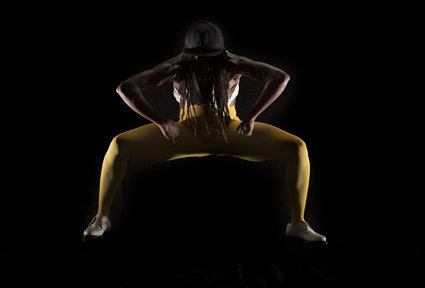
Dana Michel, Yellow Towel
photo Maxyme G Delisle
Dana Michel, Yellow Towel
Recent scholarship in performance and neuroscience reveals that spectatorship is a skill. Perception—visual, aural, olfactory and tactile—is something we learn and get good at. As spectators, we look for a challenge. Too much and we disconnect. Too little and we’re bored. Theatre scholar Bruce McConachie says spectators are always looking for a worthy play partner (Engaging Audiences, 2011). I have five days at Montréal’s FTA and I’m looking for artists with good game.
Dana Michel, Yellow Towel
A figure in black hoodie, baseball cap and pants has descended almost to the floor in an awkward splits. She has one foot in a white inflatable toilet that is beginning to collapse. The other foot is falling out of a black-and-white platform sneaker, revealing a yellow sock. Finger, arm, hip and leg move in contrary directions, each with a mind of its own. Taken as a whole, the gestures are a strange assemblage of North American Black culture clichés—everything from gangsta to Rasta to Fat Albert cartoons mashed together. Choreographer-performer Dana Michel (Band of Bless, Canada) stretches the stereotypes about as far as you can. She also transcends the clichés through uniqueness of movement and an uncompromising ability to be in the moment. Michel gives the impression of not knowing what she’s going to do from one nano-second to the next. Reporting on the weather, she gathers materials as if by accident, tearing a patch of paper from a roll and producing a marker. In a rambling manner she describes meteorological conditions that never quite add up to a forecast—all the while shifting randomly between various Black dialects. By the time she gets to the task of drawing on the paper it has been reduced to a scrunched-up ball. Dutifully and haphazardly she makes a mark on it. Yellow Towel is weird, insightful and hilarious without resorting to predictable contrivances. It achieves a state of imbalance that is revelatory.
Thomas Ostermeier, An Enemy of the People
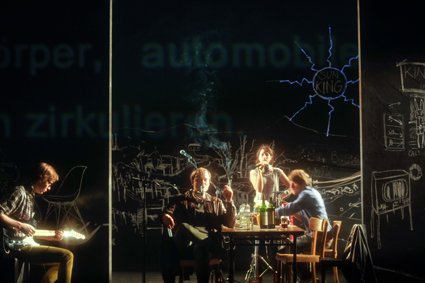
Un Ennemi du Peuple, Thomas Ostermeier
photo Arno Declair
Un Ennemi du Peuple, Thomas Ostermeier
In director Thomas Ostermeier’s (Germany) version of Ibsen’s classic play, hipster versions of Dr. Stockman and his family live in an artist warehouse where they eat, hang out with friends and rehearse covers of Gnarles Barkley and “Eye of the Tiger.” The overall impression is of a laid-back community that values creativity, free speech and the environment. But when Stockman attempts to alert the townsfolk that the local baths, a major source of revenue for the town, are polluted, he is blocked by interests at City Hall and the homeowners’ association. Science versus profit. Truth versus the evils of majority rule. What to do?
Ostermeier hands the question to the audience at Théâtre Jean-Duceppe. The furniture is pushed to the side. The actors literally try to whitewash the issue by throwing paint over the set, which now becomes the site of a town hall meeting. Actor Stefan Stern as Stockman steps up to a podium to address the house directly. Fellow cast members circulate among the audience encouraging responses.
By timely coincidence, the City of Montréal is experiencing its own water contamination issues, the result of corruption and poor management at the civic government level, so the spectators are vocal. But the issues appear to be unresolvable. This is, after all, a middle-class theatre-going crowd. Fixing such problems might require personal sacrifice in the form of higher property taxes and the like. Can a society built on the individual’s right to own property put collective good ahead of material loss? The debate is exciting, but the tendency of this theatrical form and its relatively wealthy audience is to keep the confrontation within manageable limits. We won’t be spilling into the streets to tear down the little castles—too many of us own one of them (I don’t, but I often wish I did). All things considered, the appropriate response is resignation.
Marie Brassard, Trieste
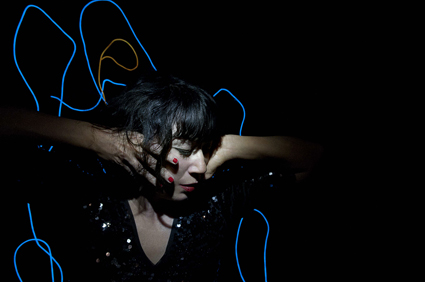
Marie Brassard, La Trieste
photo Minelly Kamemura
Marie Brassard, La Trieste
Marie Brassard (Canada) sits on a high stool front-and-centre. Clad in black from neck to foot, she recedes into the dimly lit surroundings. Her pale face seems at times to float, ghost-like, in space. She speaks of Trieste, a city haunted by literary figures of the past—Dante, Rilke, Joyce. As in her other work, Brassard creates a romantic dialogue with memory and literary history. Faded sepia images of Trieste flicker in the background, always just out of focus, as if viewed through the scratched lenses of a 19th century stereoscope. Two musicians at a table stage-left perform a sound score that is… well… typical of such sound scores—atmospheric, with even tempo and dynamically narrow. Brassard’s narration is likewise measured. Too measured—she seems hypnotised by her own voice; Trieste seems caught in its own spell. Apparently, literary ghosts are legato creatures—they don’t break rhythm. Trieste could use a staccato spectre to inject a jagged surprise or two.
Markus Ohrn, Conte d’amour
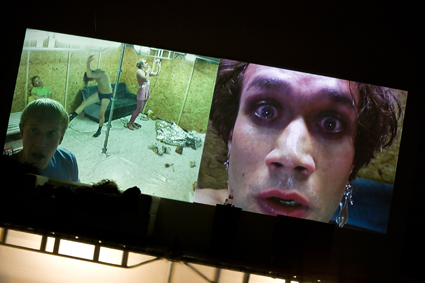
Conte d’Amour, Markus Ohrn
photo Robin Junicke
Conte d’Amour, Markus Ohrn
Spectatorship is never a passive act. We imitate what we see on a neuromuscular level. With our feeling bodies we also make predictions about what will happen next—where or how the actor will move, what she will say. Even in a seemingly static human-centred installation there is micro-movement. There is a particular quality to the unfolding of time. Unpredictability is what engages us. This seems to be lost on too many performance makers and curators. I can’t count the number of shows I’ve seen where one thing happens, I understand that thing early, and it does not change. I’m so far ahead that there is no game to play.
Markus Ohrn, director of Conte d’Amour, says he isn’t worried about boring the audience. He creates an interesting mise en scène: a two-storey structure with a living room on top and a basement underneath, the interior obscured by a thick plastic sheet. Through the sheet several figures are just barely visible, but we get plenty of close-ups of them through live video-feeds from inside the room. A father figure keeps three young men hostage there. For three hours of performance-time he plays a game of dominance and submission with them, feeding them, playing sex games etc. For about 10 minutes the feeling is of creeping horror. Then, as Ohrn intended, the banality of the situation takes over. Horror gives way to boredom and disinterest.
Ohrn, citing his favourite literary critic, argues that the act of paternalistic sex slavery, based as it is on real-life incidents of this nature, is a deviation that transforms love into its opposite. But the situations in Conte d’Amour’s and its real-life equivalents are so extreme they offer no insight into the nature of possessive love. Love has nothing to do with it. Ohrn, however, intends to drive his thesis home with facile, ‘ironic,’ biblical references to fatherhood and with too many live renderings of English-language pop songs that are oh so on-message—“Love will tear us apart again.”
From this I must conclude that Ohrn is a traditional moralist. To ensure we understand that perpetrators of such crimes are not Hollywood villains, but very banal creatures, he drip-feeds us three hours of tedium. Tough medicine, but it’ll strengthen our moral resolve. If, however, you happen to be looking for a greater aesthetic challenge, if you want to wrestle with real moral complexity, watch an episode of The Wire.
Xavier Le Roy, Le Sacre du Printemps
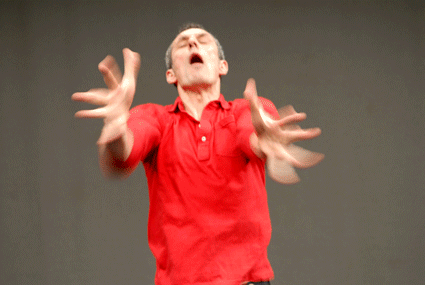
Xavier Le Roy, Le Sacre du Printemps
photos Vincent Cavaroc
Xavier Le Roy, Le Sacre du Printemps
Xavier Le Roy, one of the innovators of contemporary French non-danse, performs the part of conductor in a deconstruction of Stravinsky’s groundbreaking orchestral work The Rite of Spring. He stands alone and conducts in the direction of the audience. Audio speakers have been placed beneath our seats so that we may take on the part of specific instruments. Le Roy might gesture toward one of us as the piccolos sound, and the piccolos will announce themselves from where we sit. He does not use a baton. Rather his whole body is a hopping, thrusting, multi-limbed wand. My understanding of the word deconstruction is “to open something up to multiple meanings.” Le Roy, by embodying The Rite of Spring in this way, is opening it up to multiple hearings. I listen to the score in a new way. But, as Le Roy puts it, I also “listen to movement,” in a new way.
Festival TransAmériques (FTA), Montreal, Canada; 22 May-8 June; http://www.fta.qc.ca/en
This article first appeared as part of RealTime’s online e-dition July 10, 2013
RealTime issue #116 Aug-Sept 2013 pg. 24-25, web






